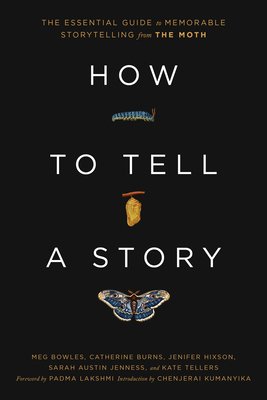
19 Jun Book Review of How to Tell a Story: The Essential Guide to Memorable S…
Review: How to Tell a Story: The Essential Guide to Memorable Storytelling by The Moth
For someone who believes in the transformative power of storytelling, How to Tell a Story: The Essential Guide to Memorable Storytelling by The Moth felt like an exhilarating invitation to dive deeper into one of my favorite subjects. As I meandered through the pages over the course of 3 ½ months, it became clear that slow consumption was the perfect antidote to the rush of our fast-paced lives. This book is a treasure trove of insights, making it worthy of a sparkling five-star rating!
From the very first pages, I found myself nodding along, immersed in the essence of what storytelling truly is. One passage hit home for me: “Every good story hinges on a decision.” This makes perfect sense. It made me think about how critical choices shape our narratives and listeners’ engagement. The Moth emphasizes that while what happened is essential, it’s our transformation through those moments—the decisions we made—that create a fireworks display for the audience.
How often do we try to one-up a storyteller or drown them out with our own experiences? I couldn’t help but smile reading, “No one will interject that their uncle did the same thing.” Ah, yes! It captures that frustrating habit perfectly—one that often disrupts the magic of storytelling. Imagine a dinner where one person has the floor, and everyone leans in attentively. True storytelling requires space and respect—qualities the book beautifully exhorts us to cultivate.
The narrative techniques explored are as varied as they are transformative. I particularly appreciated the guidance on how to dive into the heart of a story by living in the moment rather than narrating from a distance. The gentle reminder to avoid tidy phrases like “And then I realized” serves as a graceful nod to the messy nature of our lived experiences. Life doesn’t always wrap up neatly, and our stories shouldn’t either.
Some of my favorite quotes are dotted throughout, practically pulling me back for another read. “People want to hear about your mistakes and fallibility,” is a key insight that really resonates. Our imperfections create connection, a lesson I’m taking to heart as I share my own often-chaotic moments. The call to stay present in the narrative emphasizes that the memories we recount are frequently just shadows of the truth, evolving every time we recall them. It encourages us to embrace that authenticity.
As I turned the final pages, I felt a surge of gratitude for the voices this book represents, especially as it draws from a rich tradition of live storytelling at events like The Moth. The power of sharing experiences—both ordinary and extraordinary—can genuinely dismantle preconceived notions and foster understanding. And with resources for teaching storytelling to younger generations, there’s no shortage of inspiration to pass along.
In conclusion, How to Tell a Story offers a vital compass on our journey to becoming better storytellers. I wholeheartedly recommend it to anyone eager to explore the art of storytelling—be it seasoned authors, budding writers, or even casual conversationalists. The profound insights I gleaned from its pages not only changed how I view narratives but also how I approach my own stories. So grab a copy, sink into its wisdom, and maybe, just maybe, you’ll find the courage to unearth those hidden gems in your own life’s story.
Discover more about How to Tell a Story: The Essential Guide to Memorable S… on GoodReads >>









